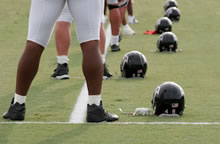
Football players are fit and capable, yet many develop high blood pressure. Researchers are looking for signs of future high blood pressure in college players.
College football players tend to have stiffer arteries than other college students, even before their college athletic careers have started, cardiology researchers have found.
Although football players had lower blood pressure in the pre-season than a control group of undergraduates, stiffer arteries could potentially predict players' future high blood pressure, a risk factor for stroke and heart disease later in life.
Researchers studied 50 freshman American-style football players from two Division I programs, Georgia Tech and Harvard, in the pre-season and compared them with 50 healthy Emory undergraduates, who were selected to roughly match their counterparts in age and race. The research is part of a longer ongoing study of cardiovascular health in Georgia Tech college football players.
The results were presented recently at the American College of Cardiology meeting in Washington DC, by cardiology research fellow Jonathan Kim, MD. Kim worked with Arshed Quyyumi, MD, director of Emory's Clinical Cardiovascular Research Institute, Aaron Baggish, MD, associate director of the Cardiovascular Performance Program at Massachusetts General Hospital, and their colleagues.
"It's remarkable that these vascular differences are apparent in the pre-season, when the players are essentially coming out of high school," says Kim. "We aim to gain additional insight by following their progress during the season."
Despite being physically active and capable, more than half of college football players were previously found to develop hypertension by the end of their first season. Professional football players also tend to have higher blood pressure, even though other risk factors such as cholesterol and blood sugar look good, studies have found. Researchers have previously proposed that the intense stop-and-start nature of football as well as the physical demands of competitive participation, such as rapid weight gain, could play roles in making football distinctive in its effects on cardiovascular health.
In the current study, the control undergraduates had higher systolic and diastolic blood pressure than the football players: (football players: 111/63; control: 118/72). However, the football players displayed significantly higher pulse wave velocity, a measure of arterial stiffness (football: 6.5 vs control: 5.7). Pulse wave velocity is measured by noninvasive devices that track the speed of blood flow by calculating differences between arteries in the neck and the leg.
"It is known that in other populations, increased pulse wave velocity precedes the development of hypertension," Kim says. "We plan to test this relationship for football players."
The football players were markedly taller and larger than the control group (187 vs 178 centimeters in height, body mass index 29.2 vs 23.7). The football players also reported participating in more hours of weight-training per week than the control group (5.4 vs 2.6).
